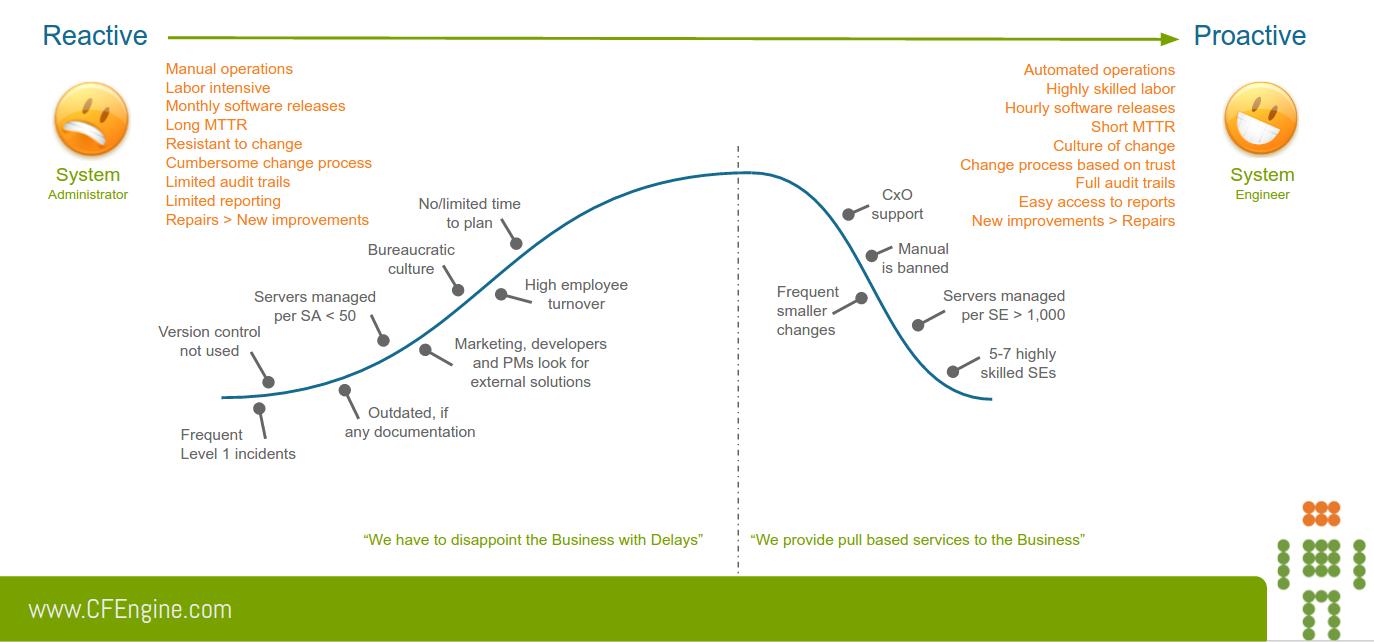As someone responsible for IT operations, you have probably spent most
of your time thinking of ways to improve your team’s effectiveness and
efficiency to make it more competitive. At CFEngine, we have witnessed
the management of IT infrastructure and organizations operating across
the spectrum of the performance scale. Where are you on that scale and
how can you improve? In the world of IT operations, a negatively skewed
distribution seems to exist. The majority of companies, despite their
admirable DevOps initiatives, struggle. The great minority who are
masters of execution continuously increase their relative
competitiveness leaving the others behind. In my previous post, “The
painful road to the digital economy,” I pointed out some ideas as to why
becoming more competitive seems so hard for Fortune 2000 companies and
suggested ways to improve. It might be worth a read if you find yourself
too far on the left side in the illustration below. The characteristics
of a poor and reactive versus proactive and high-performing IT
organization can be many. Below you will find some of the most common
observed with our own users. Have a look and compare them with your own
state of operations.

From reactive to proactive
The more proactive your organization is, the more high-performing it is. The correlation would be close to perfect. Excelling organizations, to the surprise of many, appears to be the ones who spends the most time “thinking” instead of “doing”. Thinkers leave the doing to the machines, while doers, well they are doers and never have the time to think. The first step in improving entails finding time to think. At Facebook, they have a wonderful mantra that an engineer shall never wait for the machine. The machine shall always be ready for the human. Whatever they do, they seek to ensure there is no computational waiting time. To get there you need to think, be thoughtful about every change you do and continuously seek to improve. Thoughtless execution won’t get you far. More prudence in time allocation will, for most, lead to more proactivity. Be self-aware of time. It is a good start. However and unfortunately, reactive organizations often never find the time to think, because there is no time available. In our experience, almost all leading IT organizations sooner or later gravitate towards having a cross-functional automation team of thinkers. As someone responsible for a large infrastructure, you might be able to jump ahead and hire one or two personnel in a new automation team whose only responsibility is to free up the doers to do more thinking. That action alone might bear great fruits. Tip: Create a small (1 - 2 person) automation team
Apply Zorro circles
No one becomes a champion in a day. Talent, hard work, and long-term planning is required in today’s highly competitive environment. Addressing all the characteristics in the above illustration will be overwhelming. For most IT leaders, their moonshot project should not be to “fix” IT operations. Applying the concept of gradual improvement or Zorro circles1 seems more appropriate. Focus on a few items and do not move on until these are fully mastered. Highly reactive IT operations often suffer from external locus of control which depletes progress. As someone responsible, this highly undesirable attitude can be addressed by redirecting focus to small and achievable plans.
The first circle: change
So what should be your first circle? Enforce version control everywhere, coerce SSH into individual machines, weekly deployments, master a new shiny DevOps tool, decrease mean time to repair by by something measurable, buy beer for everyone? While all of these are great ideas (especially the last one), I strongly advocate that the first circle to master is the circle of change. Change is everything. Not mastering change leads nowhere. The single biggest obstacle for improvements in Fortune 2000 companies, I would claim, is the resistance for change, a resistance melted into the walls and structure of these organizations. What can be done? Besides trying to break down walls and rigid structures, which most will fail at, just making smaller changes for the sake of change can be a good start. Minimal and perceived harmless changes lead to motion, which is important in defying rigidity. Once the wheels are in motion, change hopefully become a habit, and something that actually leads to new things/processes/results. Being able to master change is the prerequisite for addressing the characteristics mentioned above. When looking at high-performing IT organizations they change frequently. Change is their only constant. As someone responsible, mastering the process of change (based on voluntary cooperation and not management by fiat), in which the organization embraces change should be your first circle. With this circle mastered, the next circle will be much easier to move forward with, and you can gradually try to address the characteristics of proactive IT organizations. After all, what high-performing IT organizations are doing and how they operate is quite well known. The challenge revolves around getting your people to follow the recipe. 1)As much as our masked friend wanted to become the best, it was only after he mastered and felt in control of one small circle could he expand his circle to include more capabilities, before he eventually became the legend he is now known to be.


